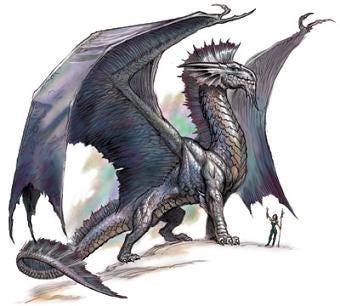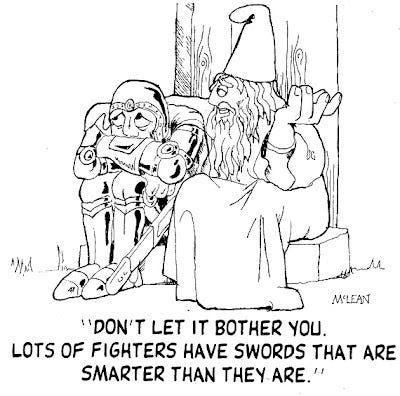Thanks for joining us on our journey to build a new and better table top RPG. If you like what you’re seeing, please share this post wherever you haunt the internet.
To read Building the Perfect Role-Playing Game - Part II, click HERE.
A brief re-cap: In our last post, we started looking at long standing RPG mechanics around Hit Points, Armor Class, Combat, and Magic. What makes sense? What doesn’t (from an heroic fantasy perspective)? What should we burn down and what should we build up? Let’s continue with:
Initiative: Combat is simultaneous. Pure and simple. Most of us understand that. Unfortunately, a completely realistic initiative system in an RPG is basically impossible. No GM wants to deal with with multiple players rolling dice and/or yelling out their actions at the same time. Although, to be fair, this probably isn’t much different from most of my gaming groups. Regardless, realistic combat doesn’t happen piece meal. It’s a huge, chaotic mess.
In D&D, a character’s initiative is heavily dependent upon their Dexterity score. That’s okay, to a point. But just because you can do a back flip shouldn’t necessarily make you much faster to react in combat.
Player: Why does it seem like Gerald always gets to go first?
DM: Have you seen him juggle? Pure delight!
What if we did something completely different? How can we make combat more realistic but still coherent? An event that is both a bit terrifying and a lot of fun.
Movement, space, and those goddamned 5’ steps: When I first started playing AD&D, movement was simple. We had drawn maps and miniatures and made reasonable estimations. Sure, if a target tried to disengage and run away from melee combat, we took a free swipe at them. However, there was no hand-wringing about grids and 5’ steps and attacks of opportunity. I realize now these were part of the rules but I feel blessed that I was never subjected to them. In fact, I didn’t know any of that existed until it came back with vengeance in 3rd Edition. Almost overnight, a game based on creativity and imagination turned into fantasy checkers. Counting squares and pinpointing vertices was so integral to combat that it took up 75% of the action. This is fine for games like Star Wars Miniatures which is primarily based on such movement. But that’s not D&D. At least not what D&D is supposed to be in my opinion.
The universe is not built on 5’ squares. There are at least a couple of variants out there that understand this and do away with the grids. 13th Age is one of them. It relies on distances such as ‘near’ and ‘far’ in combat. It feels much less robotic and helps the players’ better visualize their movement. It’s a feature well worth exploring and can help us create a movement/combat mechanic that relies on both realism and imagination.
Character Classes: Why? Seriously. Why would we do this to ourselves? For five decades D&D has leaned on character classes to define who and what the PCs are. Sure, there are sub-classes and crossover skills and feats that mimic blah, blah, blah. But at the end of the session, a PC’s class is no better than a job description. And who in the Hells wants that??
We call them them guilds, academies, colleges, tribes, clandestine organizations but in reality…well, fantasy I suppose, they’re all basically just Vo-Tech schools. Institutions that churn out fighters and mages like college grads from an MBA program. And each level gained is just another step up the corporate PC ladder.
Hey Alan, congratulations! Here’s your 4% raise and three more days of PTO. Oh and and don’t forget you gained a second attack with your favored weapon. Just like everybody else in the program…
Yeah, yeah, I get it. There are dozens of sub-classes to spice things up. Multi-classing is an option too. Hundreds of feats and spells, and thousands of combinations that will, let’s be honest, eventually lead everybody back to the same place. We’ll pick the same feats, the same spells, the same stats because that’s how the system works. And eventually the world starts to look more like a day in the life of Cincinnati, OH than a fantasy wonderland. Certainly, games like Alternity and GURPS try to buck this trend. But most d20 systems are currently all but dependent on character classes and the neat, clean lanes in which the stay. Let’s boot them and figure out how characters can explore any number of options without being tied down to some prescribed ‘progression’. There should only one character class: Adventurer.
That’s it for now. Next time, we’ll set the stage for our game by talking about some basic world building. We’ll explore what makes for a good fantasy gaming setting; the people/races/species(es), the geography, the geopolitics, why magic exists as it does, even the economy. Most importantly, we’ll talk about what motivates a regular denizen of our new world to become an adventurer in the first place.
Tell us what you think? Are we hitting on some of the same problems you’ve experienced or are we all mad? What do you think are the best ways to address a new d20 system? Leave a comment or two. We’d love to hear from you.
Cover Art: Dyson’s Logos
Dragon Art - RPG.NET
Fighter & Magic-User Art - Will Mclean






In retrospect, I think the class system shows the origins of D&D in a tabletop war game. Originally, classes were ways to define the capabilities of specific units. In Gygaxian thinking, you have to attach set attributes to specific units, represented by sets of stats. I feel like what you're suggesting is in a sense to finally cast off the limitations imposed by RPGs' origins as war games and embrace them as forms of storytelling. Though even there, you do run into the fact that genres like fantasy are replete with tropes and archetypes, which traditional classes also reflect. So you're also pushing for a less trope-bound way to tell stories, where individuals are individuals and not bound to some overarching scheme like the Warrior, the Rogue, the Wizard, etc.
Love the humor! I do like Cypher's approach to character definition (let's call it), where you basically choose an adjective, a noun, and a verb, each of which comes with a set of features (You're a Sad Clown who Levitates, or whatever). As I mentioned before, though, I don't think that system gives the character enough to do. But I think a more "a la carte" way to build characters from sets of features could get rid of class and maximize customization. It could basically be just a bunch of different feats at different levels of "beef," and the rules could stipulate how many you start with and then how many you add as the character develops. I've seen this in a D&D context in one of the third-party attempts to provide an alternative to race in the initially published version of 5e. Characters of mixed lineages can basically choose which features they want, with more powerful features being limited through a point system (e.g. You've got 5 points to spend on features. Here are the 3-points ones, here are the 2-point ones, and here are the 1-point ones).